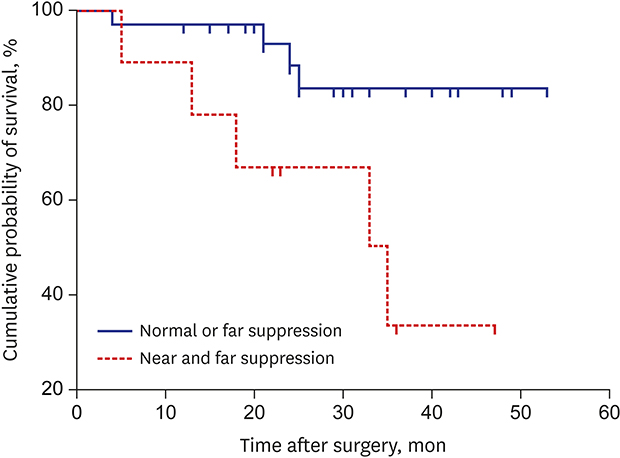1. Maruo T, Kubota N, Sakaue T, Usui C. Intermittent exotropia surgery in children: long term outcome regarding changes in binocular alignment. A study of 666 cases. Binocul Vis Strabismus Q. 2001; 16(4):265–270.
2. Kushner BJ. Selective surgery for intermittent exotropia based on distance/near differences. Arch Ophthalmol. 1998; 116(3):324–328.

3. Jeoung JW, Lee MJ, Hwang JM. Bilateral lateral rectus recession versus unilateral recess-resect procedure for exotropia with a dominant eye. Am J Ophthalmol. 2006; 141(4):683–688.

4. Chia A, Seenyen L, Long QB. Surgical experiences with two-muscle surgery for the treatment of intermittent exotropia. J AAPOS. 2006; 10(3):206–211.

5. Wu H, Sun J, Xia X, Xu L, Xu X. Binocular status after surgery for constant and intermittent exotropia. Am J Ophthalmol. 2006; 142(5):822–826.e2.

6. Lee JY, Ko SJ, Baek SU. Survival analysis following early surgical success in intermittent exotropia surgery. Int J Ophthalmol. 2014; 7(3):528–533.
7. Lim SH, Hwang BS, Kim MM. Prognostic factors for recurrence after bilateral rectus recession procedure in patients with intermittent exotropia. Eye (Lond). 2012; 26(6):846–852.

8. Kushner BJ, Fisher MR, Lucchese NJ, Morton GV. Factors influencing response to strabismus surgery. Arch Ophthalmol. 1993; 111(1):75–79.

9. Gezer A, Sezen F, Nasri N, Gözüm N. Factors influencing the outcome of strabismus surgery in patients with exotropia. J AAPOS. 2004; 8(1):56–60.

10. Richard JM, Parks MM. Intermittent exotropia. Surgical results in different age groups. Ophthalmology. 1983; 90(10):1172–1177.
11. Stoller SH, Simon JW, Lininger LL. Bilateral lateral rectus recession for exotropia: a survival analysis. J Pediatr Ophthalmol Strabismus. 1994; 31(2):89–92.

12. Beneish R, Flanders M. The role of stereopsis and early postoperative alignment in long-term surgical results of intermittent exotropia. Can J Ophthalmol. 1994; 29(3):119–124.
13. Scott WE, Keech R, Mash AJ. The postoperative results and stability of exodeviations. Arch Ophthalmol. 1981; 99(10):1814–1818.

14. Hahm IR, Yoon SW, Baek SH, Kong SM. The clinical course of recurrent exotropia after reoperation for exodeviation. Korean J Ophthalmol. 2005; 19(2):140–144.

15. Luk AS, Yam JC, Lau HH, Yip WW, Young AL. Surgical outcome of medial rectus resection in recurrent exotropia: a novel surgical formula. J Ophthalmol. 2015; 2015:758463.

16. Ren MY, Wang T, Wang Q, Guo JL, Wang LH. Unilateral medial rectus resection for the treatment of recurrent exotropia in children. Jpn J Ophthalmol. 2015; 59(5):341–345.

17. Burian HM, Spivey BE. The surgical management of exodeviations. Am J Ophthalmol. 1965; 59(4):603–620.
18. Oh JY, Hwang JM. Survival analysis of 365 patients with exotropia after surgery. Eye (Lond). 2006; 20(11):1268–1272.

19. Yildirim C, Mutlu FM, Chen Y, Altinsoy HI. Assessment of central and peripheral fusion and near and distance stereoacuity in intermittent exotropic patients before and after strabismus surgery. Am J Ophthalmol. 1999; 128(2):222–230.

20. Cooper J, Feldman J, Pasner K. Intermittent exotropia: stimulus characteristics affect tests for retinal correspondence and suppression. Binocul Vis Strabismus Q. 2000; 15(2):131–140.
21. Adams WE, Leske DA, Hatt SR, Mohney BG, Birch EE, Weakley DR Jr, et al. Improvement in distance stereoacuity following surgery for intermittent exotropia. J AAPOS. 2008; 12(2):141–144.

22. Stathacopoulos RA, Rosenbaum AL, Zanoni D, Stager DR, McCall LC, Ziffer AJ, et al. Distance stereoacuity. Assessing control in intermittent exotropia. Ophthalmology. 1993; 100(4):495–500.
23. O'Neal TD, Rosenbaum AL, Stathacopoulos RA. Distance stereo acuity improvement in intermittent exotropic patients following strabismus surgery. J Pediatr Ophthalmol Strabismus. 1995; 32(6):353–357.
24. Kim JH, Kim HJ, Choi DG. Contralateral lateral rectus recession versus recess-resect for recurrent exotropia after unilateral recess-resect. Br J Ophthalmol. 2013; 97(6):752–756.

25. Diamond GR, Parks MM. The effect of superior oblique weakening procedures on primary position horizontal alignment. J Pediatr Ophthalmol Strabismus. 1981; 18(1):35–38.












 PDF
PDF Citation
Citation Print
Print




 XML Download
XML Download